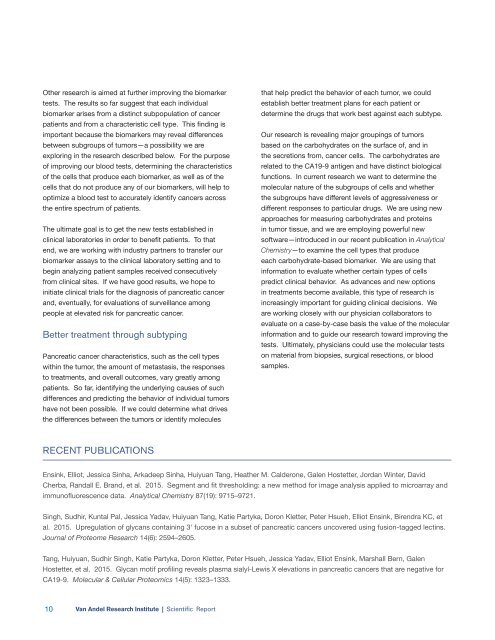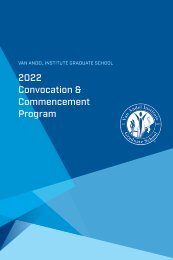2016 Scientific Report
Create successful ePaper yourself
Turn your PDF publications into a flip-book with our unique Google optimized e-Paper software.
Other research is aimed at further improving the biomarker<br />
tests. The results so far suggest that each individual<br />
biomarker arises from a distinct subpopulation of cancer<br />
patients and from a characteristic cell type. This finding is<br />
important because the biomarkers may reveal differences<br />
between subgroups of tumors—a possibility we are<br />
exploring in the research described below. For the purpose<br />
of improving our blood tests, determining the characteristics<br />
of the cells that produce each biomarker, as well as of the<br />
cells that do not produce any of our biomarkers, will help to<br />
optimize a blood test to accurately identify cancers across<br />
the entire spectrum of patients.<br />
The ultimate goal is to get the new tests established in<br />
clinical laboratories in order to benefit patients. To that<br />
end, we are working with industry partners to transfer our<br />
biomarker assays to the clinical laboratory setting and to<br />
begin analyzing patient samples received consecutively<br />
from clinical sites. If we have good results, we hope to<br />
initiate clinical trials for the diagnosis of pancreatic cancer<br />
and, eventually, for evaluations of surveillance among<br />
people at elevated risk for pancreatic cancer.<br />
Better treatment through subtyping<br />
Pancreatic cancer characteristics, such as the cell types<br />
within the tumor, the amount of metastasis, the responses<br />
to treatments, and overall outcomes, vary greatly among<br />
patients. So far, identifying the underlying causes of such<br />
differences and predicting the behavior of individual tumors<br />
have not been possible. If we could determine what drives<br />
the differences between the tumors or identify molecules<br />
that help predict the behavior of each tumor, we could<br />
establish better treatment plans for each patient or<br />
determine the drugs that work best against each subtype.<br />
Our research is revealing major groupings of tumors<br />
based on the carbohydrates on the surface of, and in<br />
the secretions from, cancer cells. The carbohydrates are<br />
related to the CA19-9 antigen and have distinct biological<br />
functions. In current research we want to determine the<br />
molecular nature of the subgroups of cells and whether<br />
the subgroups have different levels of aggressiveness or<br />
different responses to particular drugs. We are using new<br />
approaches for measuring carbohydrates and proteins<br />
in tumor tissue, and we are employing powerful new<br />
software—introduced in our recent publication in Analytical<br />
Chemistry—to examine the cell types that produce<br />
each carbohydrate-based biomarker. We are using that<br />
information to evaluate whether certain types of cells<br />
predict clinical behavior. As advances and new options<br />
in treatments become available, this type of research is<br />
increasingly important for guiding clinical decisions. We<br />
are working closely with our physician collaborators to<br />
evaluate on a case-by-case basis the value of the molecular<br />
information and to guide our research toward improving the<br />
tests. Ultimately, physicians could use the molecular tests<br />
on material from biopsies, surgical resections, or blood<br />
samples.<br />
RECENT PUBLICATIONS<br />
Ensink, Elliot, Jessica Sinha, Arkadeep Sinha, Huiyuan Tang, Heather M. Calderone, Galen Hostetter, Jordan Winter, David<br />
Cherba, Randall E. Brand, et al. 2015. Segment and fit thresholding: a new method for image analysis applied to microarray and<br />
immunofluorescence data. Analytical Chemistry 87(19): 9715–9721.<br />
Singh, Sudhir, Kuntal Pal, Jessica Yadav, Huiyuan Tang, Katie Partyka, Doron Kletter, Peter Hsueh, Elliot Ensink, Birendra KC, et<br />
al. 2015. Upregulation of glycans containing 3' fucose in a subset of pancreatic cancers uncovered using fusion-tagged lectins.<br />
Journal of Proteome Research 14(6): 2594–2605.<br />
Tang, Huiyuan, Sudhir Singh, Katie Partyka, Doron Kletter, Peter Hsueh, Jessica Yadav, Elliot Ensink, Marshall Bern, Galen<br />
Hostetter, et al. 2015. Glycan motif profiling reveals plasma sialyl-Lewis X elevations in pancreatic cancers that are negative for<br />
CA19-9. Molecular & Cellular Proteomics 14(5): 1323–1333.<br />
10<br />
Van Andel Research Institute | <strong>Scientific</strong> <strong>Report</strong>

















